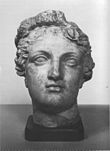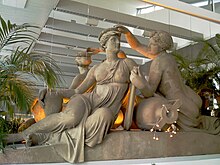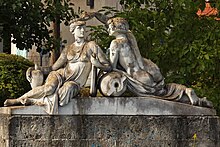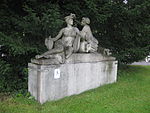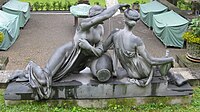Water and meadow nymph
The water and meadow nymph is a sculpture by Johann Heinrich Dannecker , which was first executed in 1810–1815 by Friedrich Distelbarth under Dannecker's supervision. It is often referred to as the nymph group or Dannecker's group of nymphs , in older literature also as meadow nymph, wreathing the water nymph out of gratitude .
description
| Work title | Water and meadow nymph |
| Artist | Johann Heinrich Dannecker |
| Art | sculpture |
| motive | The meadow nymph wreaths the water nymph out of gratitude. |
| material | differently |
| Dimensions | differently |
| Year of origin | first model: 1808, first copy: 1810–1815 |
| Location | Models: Stuttgart, copies: Stuttgart and Tübingen |
The information on the left and right refer to the front view (see figure on the right), for body parts they apply from the perspective of the figure.
In 1987, the art historian Christian von Holst gave a short, apt description of Dannecker's group of nymphs in his Dannecker catalog ( Holst 1987 ):
- “With this classic pair of sisters in a half-sitting, half-lying position, the outline of which could be inscribed in a flat triangle, the artist made very conscious reference to the architectural background of the installation site. The gable of the castle echoes the broad structure of the group.
- A major work of German sculpture of the early 19th century was created in the alternation of well-designed nudity and thin veilings that flatter the body shape, [...] through doubling, variation, juxtaposition of front and back figures, an altogether contrapostic way of composing . "
- ( Holst 1987 , p. 322)
The young couple of the two nymphs are resting in a half-sitting, half-lying pose on a low, backless couch , their bodies leaning towards each other and their legs stretched to one side.
The almost completely veiled water nymph holds her upper body upright and faces the viewer head-on, with curved hips and slightly bent, outstretched legs. With her left elbow she leans on a large, fat belly vase ( amphora ) and almost touches her sister's elbow, while she holds a lyre in her hand . The outstretched right arm rests with the hand casually on a slim, tall vase ( jug ).
The scantily clad meadow nymph turns her back on the viewer. She lies on the couch with her legs slightly drawn up and lying on top of each other, her left hip leaning against the amphora and her bent left arm supported on it. Her body strives towards her sister in a dynamic, diagonal sweep. She stretches out her right arm and crowns the sister's head with a wreath of flowers as a sign of gratitude for the life-giving water that the water nymph pours over the sister's meadows.
Models and copies
The models are numbered from M1 to M5 and the copies from K1 to K6.
Dannecker made at least five models of the nymph group or had them made. His first draft for the group of nymphs was a small baked clay sketch from 1808 (M1), which was probably destroyed in the Second World War. A plaster cast of the somewhat larger, already worked out M2 model has been preserved. Of the probably life-size model M3, only the plaster cast of a nymph's head has survived, which shows traces of stippling for transfer into marble.
The other two models, M4 and M5, were used to make copies. Friedrich Distelbarth created the first, double life-size version of the group of figures (K1) based on the life-size plaster model M4 in sandstone under Dannecker's supervision. This version can therefore be regarded as authorized by him and it can be assumed that the changes compared to the underlying M4 model were intended by him.
After the "original copy" K1, further copies were made: the marble copy K2 (1922–1926) by Adolf Fremd and Kurt Fanghänel, which was destroyed in World War II, the marble copy K5 by Doris Schmauder (1982) and the artificial stone K6 by Hans Volker Dursy (1986). Kurt Fang Hänel also created a 1: 1 copy in artificial stone (K3) of the M4 model. A cast zinc copy (K4) has been preserved from the lost three-quarters life-size plaster model M5.
Models
| model | image | description | ||||||||||||||
|---|---|---|---|---|---|---|---|---|---|---|---|---|---|---|---|---|
|
|
Clay model
|
|||||||||||||||
|
|
Model cast
|
|||||||||||||||
|
|
Model fragment
|
|||||||||||||||
|
|
Life-size model
|
|||||||||||||||
|
|
Three-quarter life-size model
|
Copies
| Copy | image | description | |||||||||||||||||
|---|---|---|---|---|---|---|---|---|---|---|---|---|---|---|---|---|---|---|---|
|
|
|
||||||||||||||||||
|
|
|
||||||||||||||||||
|
|
|
||||||||||||||||||
|
|
|
||||||||||||||||||
|
|
|
||||||||||||||||||
|
|
|
history
The first copy of Dannecker's group of nymphs was the monumental version of Distelbarth (K1), which was completed between 1810 and 1815. It was set up in Stuttgart by the garden wing (north wing) of the New Palace on a high pedestal, at the beginning of a canal that flows into the Upper Plant Lake. In 1839 the canal was filled in and the group moved directly to the lake so that the front view could only be seen from a distance from the opposite shore of the lake. In 1926 the sandstone copy was replaced by the marble copy K2 by Adolf Fremd and Kurt Fanghänel. It was destroyed in a bomb attack in 1944, but the torso of the meadow nymph and the head of the water nymph were saved. In 1982 Doris Schmauder created the marble copy K5 as a replacement , which was set up in the basin in front of the main entrance of Rosenstein Castle.
The distelbarth copy was moved to Tübingen on the plant lake in 1926, was completely overhauled in 1985–1986 and placed again in 1991 in the literature café of the Tübinger Kunsthalle so that only the front is visible (you can see sections of the back in the mirror behind it). The stone cast copy K6 by Hans Volker Dursy was installed at the Tübingen Plant Lake to replace the original . The front of the group can only be viewed head-on from the far opposite bank of the lake.
In 1926 the life-size artificial stone copy K3 by Kurt Fanghänel was set up on the open-air site of the Stuttgart mineral baths (reverse side covered), and around 1933 the three-quarters life-size cast zinc copy K4 in the municipal lapidarium.
reception
The beautiful nymphs had a hard time with the "normal" population (not with the art experts). The scandalous nudity of the nymphs was then an imposition for a public installation site. At the time of its formation and decades afterwards, the group of nymphs had to struggle with the moral uptightness of their Biedermeier contemporaries. It is said that the strollers of the fine Stuttgart society turned a wide berth around the sculpture out of moral indignation. In doing so, Dannecker had already significantly reduced the nudity of the nymphs, especially that of the meadow nymph, compared to his first draft (M1).
Dannecker's bust of Lavater, his bust of Schiller and his Ariadne on the panther provoked the contemporary art enthusiasts to all kinds of laudatory and often exuberant expressions of opinion. Amazingly, his group of nymphs received comparatively little attention from the art world. The statement of the not insignificant art publisher Ernst Arthur Seemann (1829–1904), who classified the forest and meadow nymphs as one of Dannecker's "less important works" ( Seemann & Clément 1865 , page 377), could appear almost typical . The nymph group is undoubtedly one of Dannecker's most popular creations. Even today, the tender, peaceful harmony of the two familiar sisters does not fail to have an effect on the viewer.
The art historian and Dannecker biographer Adolf Spemann (1886–1964) was full of praise for Dannecker's nymphs in 1909: “Strangely enough, the group of the two nymphs on Stuttgart's upper plant lake never achieved the same fame as Ariadne. I would like to see in her the crown of all Dannecker's creations; the great success has been achieved, style and study of nature have come to a wonderful union. ”( Spemann 1909 , page 85). In the Stuttgart tourist guide from 1858 it was said: “The work, equally beautiful and perfect, from whichever side you look at it, makes an excellent impression thanks to the clever idea, beauty of the proportions for all body sizes, harmony of form and correctness of execution. “( Büchele 1858 ).
A contemporary art historian, Christian von Holst, describes the clay sketch M1 in 1987 as "a work of enchanting sensual charm" and the nymph group as "a major work of German sculpture of the early 19th century" ( Holst 1987 , pages 321, 322).
iconography
Nothing more is known about the genesis of the Dannecker nymph group. You don't know which role models Dannecker knew, what suggestions he received and processed, and you don't know how his ideas developed. Nevertheless, there was and is speculation about possible role models for the nymph group.
Photo 2: Water nymph by Pierre François Lejeune
Image 3. River goddess Isar in the Nymphenburg palace park in Munich by Giuseppe Volpini
Image 4. Nymph at Sanssouci Palace in Potsdam by Christian Glume
In an essay in 1908, the art historian Heinrich Brockhaus suggested that Dannecker was inspired to create his nymphs by a Florentine gem from the 16th century (Fig. 1). The gem shows a tiny island in the middle of the sea, with a palm and two deciduous trees, a grotto and dolphins swimming around. On the island, which is designed in a side view similar to the lounger in Dannecker's group of nymphs, two people rest, also half sitting, half lying. An almost fully clothed woman turns to the viewer and holds a vase of flowers with a large plant in her right hand, her outstretched left arm is supported with one hand on the roof of the grotto on which the palm tree grows. The other person is a naked man with his back turned to the viewer. With his left hand he embraces the trunk of the palm tree, his right hand arches over his head and points with his index finger at the woman. There is no doubt that the composition and some details of the gem are similar to those of the Dannecker group, but to speak with Christian von Holst, “It can only be a small suggestion, because, as Brockhaus himself states, the artist offers much more, when he found "( Holst 1987 , p. 322).
Von Holst suggests another possible source: "In this context, there is also a Dannecker, even more easily accessible, stored water nymph from the Ludwigsburg factory , the model of which is attributed to his teacher Lejeune" ( Holst 1987 , page 322). This naked water nymph (picture 2), holding up a mirror to two putti, has little in common with Dannecker's nymphs apart from the sitting-lying position and the thick amphora. This also applies to many other sitting and reclining nymphs (e.g. Fig. 3–5), but also to many other half-seated, half-reclining figures in art history.
Image 5. Nymph with a shell by Antoine Coysevox
Fig. 6. Reclining bacchants by Johann Christian Wilhelm Beyer
Fig. 7. River nymph by Domenico Ferretti
In the Ludwigsburg manufactory there are still pairs of porcelain figures that could have served as inspiration for Dannecker. The reclining Bachanten by Johann Christian Wilhelm Beyer (picture 6) show a similar constellation of two lying figures as the group of nymphs. The river nymph and the river god by Domenico Ferretti (Fig. 7–8) are individual pieces, but they form (like a pair of bookends) an ensemble that has certain parallels to the group of nymphs.
According to Christian von Holst, "such parallels do not really lead to the work, let alone that they could explain its creation" ( Holst 1987 , p. 322). Ultimately, the beautiful siblings have to be recognized as an independent creation by Dannecker for which there are no direct models.
gallery
Models
Copies
Details
Note:
- Instead of the models M4 and M5, the figures show the copies K1 and K4, respectively, because there are no images of M5 and no detailed images of M4.
- The M3 model is not taken into account, as only the head of the water nymph has survived. Copies are only discussed if they differ from the underlying model.
Lounger
The platform, on which the half-lying, half-seated nymphs rest laterally, fulfills the function of a low, backless couch. It slopes down to the sides and is raised in the back by a step-like shoulder. In the first draft, M1, the pedestal slopes continuously towards the sides.
lyre
The water nymph embraces the lyre in her left hand. The lyre stands upright and leans slightly forward in the middle of the pedestal, to the left of the amphora lying on the floor. The lyre consists of a bell and two bulging arms that are connected by a cross yoke. The strings are stretched between the cross yoke and the sounding body.
- With M1 the lyre is half as big as with the other models, hardly higher than the amphora diameter. With M4 the lyre shown is a lyre with a flat, circular sound body. The arms run parallel over the stomach. Both arms have a flat, octagonal profile. The lyre is strung with three strings. In M2 and M5 the lyre shown is a kithara with a rectangular sound body, which is provided with seven sound holes on each side. The arms swing in and out of the stomach in an S-shape. The left arm has a flat, octagonal profile, the right a square cross-section. The lyre is strung with seven strings at the front and (strangely) with three strings at the back. At K1 the arms end in a short, cylindrical end piece.
Amphora
The amphora lies between the two nymphs in the middle of the pedestal, with the mouth of the vessel pointing forward. Both nymphs support themselves with one bent arm on the belly of the amphora.
The shape of the vase is an amphora, but only in the "original copy" K1 by Distelbarth has two handles. Since the vase on the platform is located , it is a Quellamphore that (a nymph here) is used to from the water nymph to the spring water to pour. Depending on the model or copy, the vase has a low foot or a spherical base, an egg-shaped belly, a horizontally recessed or round shoulder and a narrow or wide neck, with or without a closing mouth plate.
- At M1 the vase has a low cylindrical base. The horizontal shoulder swings into the wide cylindrical neck, which is not closed by a muzzle plate. In the case of M4, the vase does not have a foot, but a spherical bottom. The round shoulder swings into the cylindrical neck, which is closed by a bulging, wider muzzle plate. The vessel opening is closed by an embedded disk, but a thin jet of water can flow out of a small hole in the middle of the disk, as was originally said to have been the case with K1. In the case of the M2 and M5, the vase has a low base with a wider base and a narrower, cylindrical intermediate piece. The horizontal shoulder swings into the cylindrical neck, which is closed by a bulging, wider muzzle plate. The vessel opening is closed in a concave manner. At K1 the neck is closed by a disc-shaped, wider muzzle plate. The vessel opening is not closed. The handles are made as flat bands and run vertically from the shoulder to the level of the mouth, where they bend at right angles and then merge into the wide, disc-shaped mouth plate. The lying amphora is turned in such a way that the muzzle plate with the opening handles forms a diagonal, the upper end of which points to the meadow nymph.
Jug
The water nymph holds the jug in her right arm, which is on the top of the pedestal in the far left corner. In the first draft M1, still conceived as a jug (with a handle but without a spout), the vessel has lost the handle in all other models or copies, so that it has become a simple vase. Since the vase belongs to a water nymph, it has to serve the purpose of a jug. Depending on the model or copy, the vase has a short foot with or without a stem, a slender, obovate belly, a tubular or goblet-shaped neck with an equally wide or wider mouth plate. At K1, the vase is connected to one of the water nymph's thighs by a support bar.
- With the M1, the simple foot does not have an additional base plate. The wide, tubular neck ends in an only slightly protruding muzzle plate. The vertical handle (ear handle) extends from the lower third of the abdomen to the shoulder. In M2, the foot consists of a base plate and a wide handle that goes directly into the stomach. The neck swings out like a funnel towards the muzzle plate, which ends with the neck. In the case of the M4 and M5, the foot consists of a base plate and a tapered handle that is clearly separated from the stomach. The narrow, tubular neck ends in an only slightly protruding muzzle plate. The neck of the vase is missing in K1 (in August 2010; probably broken off).
Faces
With their Greek profile, the faces of the nymphs obey the classical, ancient ideas of beauty. The head sits on a long, slender neck. The oval face is also long and narrow. No wrinkles or wrinkles permeate smooth, youthful skin.
The straight forehead merges into the flat bridge of the nose so that the forehead and nose form a straight line. The sharply drawn eyebrows flow seamlessly into the bridge of the nose in a perfect arch. The nose is long and evenly narrow and ends in pronounced nostrils. The narrow mouth is characterized by full pursed lips, a short upper lip with strikingly curved wings, a slightly open mouth gap and clear, raised corners of the mouth. The full, high-set chin is narrow and arched plastically and does not protrude beyond the line of the lips. The large, almost almond-shaped eyes are set deep in the eye socket. Since the pupil holes are missing, the view appears indefinite and veiled. The well-formed cheeks with slightly protruding cheekbones run in an oval arc down to the chin. The wreath of hair only half exposes the ears with their wide shells and free earlobes.
The unmoved face of the water nymph looks serious and solemn. Your gaze seems to be directed far away. The meadow nymph, on the other hand, with a slight smile playing around her mouth, turns her gaze friendly to her sister, who puts on the wreath of flowers.
Hairstyles
Water nymph. The hair, which is parted in the middle, is combed back on the top of the head in smooth, thick strands in a curved shape and tightly fitting. The hair on the back of the neck is tied up in a knot at the back of the head and covered by a cloth that ends in a screen of bay leaves on the forehead. Like a wreath wrapped around the head, curly strands of hair and frizz oozing out from under the ring-shaped headscarf on the sides and in the neck.
Meadow nymph. The thick strands of the heavily wavy head hair, divided by a central part, flow from the forehead to the back of the head. The long hair on the neck is twisted crosswise in a wide strand back to the forehead, where the individual strands are tied together in a voluminous, artistic knot. The protruding ends fall into the forehead as curly fringes on both sides. A band of fabric that starts behind the knot and runs to the back of the head keeps the hair in check.
- Naturally, the hairstyles in the first sketch M1 are much more coarsely worked out than in the other models.
clothing
The water nymph, to whom nudity would suit her wet element, is well dressed in comparison to her almost naked sister, apart from a few uncovered spots.
Water nymph. An ankle-length, artfully pleated tunic hugs the beautiful figure of the nymph. Tied under the breast with a ribbon and over the left shoulder with a fibula, the robe leaves the arms and one side of the torso, from the chest down to the hips, uncovered.
Meadow nymph. The meadow nymph's tunic, which has slipped down, reveals the shapely back to under the buttocks, as well as shoulders, breasts and one leg. In front of her body, the nymph gathers the tight-fitting, wafer-thin robe, which hides little more than shame, with her left arm, which she holds wrapped in the cloth of the robe as if in a gauntlet-length gauntlet.
- Compared to the other models, which hardly differ in this regard, the clothing of the nymphs on M1 is even sparser. In the case of the water nymph, the right half of the abdomen, approximately to the navel, is exposed. The meadow nymph's left buttock is half covered, but its front is almost completely naked, and the garment that has slipped away only covers the legs from the knees down.
literature
- Heinrich Brockhaus: Dannecker's fountain in the palace garden in Stuttgart . In: Communications from the Kunsthistorisches Institut in Florenz , 1.1908, pp. 28–31.
- Karl Büchele: Stuttgart and its surroundings for locals and foreigners , Stuttgart 1858, page 237-238 [1] .
- Axel Clesle: Johann Heinrich Dannecker , Stuttgart 2009. See also: PDF .
- Werner Fleischhauer: The High Carls School , Stuttgart 1959.
- Karl Grüneisen: About the works of art of the royal country house Rosenstein near Stuttgart . In: Morgenblatt for educated estates, Kunst-Blatt , No. 73, 289–291.
- Christian von Holst: Johann Heinrich Dannecker. The sculptor , Stuttgart 1987, pages 319-324.
- Helmut Hornbogen: Dannecker's group of nymphs. About the eventful past and diverse present of two lightly clad women , Tübingen 1991.
- Manfred Schmid: Urban Lapidarium. Museum Guide , Stuttgart [2006].
- Ernst Arthur Seemann; Charles Clément: Art and Artists of the 16th, 17th and 18th Centuries: Biographies and Characteristics. Art and Artists of the Eighteenth Century , Volume 3, Leipzig 1865.
- Adolf Spemann: water and meadow nymph . In: Adolf Spemann: Dannecker , Berlin 1909, pages 85–87.
- Gustav Wais: Stuttgarts Kunst- und Kulturdenkmale , Stuttgart [1954].
Web links
Individual evidence
- ↑ Christian von Holst suspects the existence of another, probably lost, model: “A small bozzetto that has been ' cleaned up' must soon have followed this sketch. Its appearance is passed down by the plaster casts that are widely used as room decorations, which form a perfect match with the final design. ”( Holst 1987 , page 321).
- ↑ The lake was popularly known as the “Epaulett Lake” because its layout resembled the shoulder pieces ( epaulettes ) of military uniforms. After the establishment of the court theater (today the Great House of the Stuttgart State Theater ) in 1909–1912, the lake was also called the theater lake. Because of its current angular shape, the lake is now called Eckensee.
- ↑ Photo from around 1895, when the group was set up in Stuttgart on the Upper Plant Lake.
- ↑ The copy K2 was destroyed by bombs in 1944, only the torso of the meadow nymph and the head of the water nymph remained.
- ↑ The copy K3 is set up so close to a sprawling yew tree that the reverse cannot be photographed.





